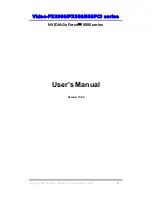
56
Appendix H: About Plug-and-Play Technology
EtherFast 10/100 LAN Card
Appendix H: About Plug-and-Play Technology
The EtherFast® 10/100 LAN Card is designed to run in a 32-bit desktop computer equipped with PCI expansion
slots. The Card is built to the PCI 2.1 standard.
Short for Peripheral Components Interconnect, PCI is a technology that allows special Plug-and-Play expansion
cards to be automatically configured by a computer’s BIOS (Basic Input/Output System) once they have been
installed. (Refer to your computer’s user guide for more information about its BIOS.)
When a PCI card is used in a computer that supports Plug-and-Play, the card is automatically configured each
time the computer is booted. The card's IRQ, I/O address, and other operating parameters are automatically
assigned.
There is no easy way to change a Plug-and-Play card's IRQ and other settings outside of the BIOS menu(s) that
your computer provides. If the resources that are assigned to the EtherFast® 10/100 LAN Card seem to conflict
with other devices in your computer, you will need to use your system's BIOS to resolve the conflicts. If you have
problems configuring your BIOS or resolving IRQ or other hardware conflicts, consult your computer’s manual or
contact your PC's manufacturer for BIOS setup and configuration directions. Here are some general guidelines to
follow when installing a PCI card (such as the LAN Card) into your computer:
1. The EtherFast® 10/100 LAN Card should be used in a 32-bit PCI slot that supports PCI Bus Mastering. It cannot
be plugged into a PCI Bus Slave slot. Consult your motherboard's documentation for more information on master
and slave slots.
2. If loading the EMM386.EXE program in your PC's CONFIG.SYS, you must use version MS-DOS 6.22 or above. If
you load an older EMM386.EXE program (below DOS 6.22), your PC will hang up while loading the network driver.
3. When using NT, set your system’s PnP OS option in the BIOS settings to MANUAL or DISABLE. NT is not a Plug-
and-Play OS, and will not usually recognize LAN cards if they are set to be automatically detected and configured.
If you need to configure your PC's BIOS in order to resolve an IRQ or other conflict with the EtherFast Card, there
are a few possibilities:
No Changes Allowed: Your PC may not allow you to change the IRQ value(s) of the PCI slot(s). In this case, you will
ONLY be able to use the IRQ and I/O values that have been pre-assigned to each slot. The popular BIOS from
Phoenix, for example, does not generally allow you to modify BIOS-assigned IRQ settings.
Jumper Changes: You may be able to change the IRQ & I/O values for a given PCI slot by setting jumpers on your
PC motherboard. Please refer to your PC's motherboard user guide for specific instructions.
















































